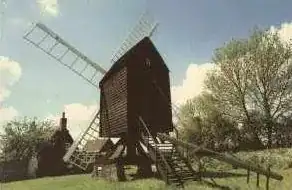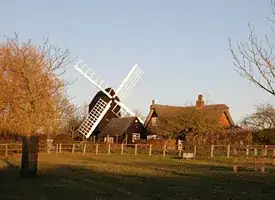Short answer:
"Windmills always turn counter-clockwise" - False, it depends
"Irish windmills turn clockwise" - False, it depends too
Long Answer:
The older windmills have any spinning CW or CCW, in fact in the district of Cambridgeshire, England, you have an example of nearby similar mills whose sails rotate in opposite directions in Cambridgeshire at Bourn (anticlockwise) and Great Gransden (clockwise). reference, here are some not so great pictures:
Cambridgeshire at Bourn (anticlockwise)

Reference: Here

Reference: Here
Great Gransden (clockwise)

Reference: Here
As you can check in my studies (for the fun), and in this Website, the spinning depends of the shape of the blade... and the likes of the owner. Why?, well because...
In olden times all of the 'dutch' type of windmills turned left and there was a reason for that. The sails were rigged on long pegs that were driven right through the spars and stuck out a long way beyond toward the trailing edge. The windmiller would hammer these pegs through the main spar, climbing up them like a ladder from the tip as he went. Being mostly right handed, they preferred if the pegs went in from the right hand side and so the trailing edge was on the left of the sweep. This made the sails turn anticlockwise.
Reference: Here, discussion board
Modern Windmills enforce this, for the practical reason, the nuts and the force:
If your prop is attached to the generator using a Single Bolt or Nut, then you would want it to rotate Clockwise which would keep it tightened up.
Reference: Here, same discussion board
For a VAWT, a clockwise rotation will create a force in the downward direction and an anti clockwise rotation will create a force is the upward direction. The greater the spin, the larger the force.
For a HAWT, a clockwise rotation will create a force with the wind and an anti clockwise rotation will create a force into the wind.
The forces are created by the angular momentum of a spinning object. If you want a visual, do a youtube search for the topic "angular momentum".
Reference Here, the same discussion board
So for both types of windmill/wind turbines the clockwise rotation "keep the system in place"
but lastly the proper design of the blades instead of just "put the blades in the opposite direction" will reverse this effect.
CW as seen on this video here, here or there.
CCW as seen in this Video, also here or here and here.
A weird mix CW and CCW turbines in this video (Seconds 0:30 - 0:40)
Lastly in a related question Physics SE, we can see that the latest wind turbine generators take great care to prevent "reverse spinning" and have two sets of turbines (CW and CCW type) will just add cost and work overhead.
Conclusion
"Windmills always turn counter-clockwise" - False, it depends of the design and construction of the wind mill or wind turbine. Mainly right handedness of the builder/fixer in the older ones for CCW and Bolt/nuts design for CW in the-not-so-old windmills.
Wind turbines can go either way, but company/market policies dictate a CW or CCW for supplies (blades and generators), maintenance manuals, personal training and connection to the power grid (see physics SE).
"Irish windmills turn clockwise" - False, it depends too, same reason as above.
Reference:
Civil Engineering University course UTFSM, Chile. So trust me, I'm a engineer


